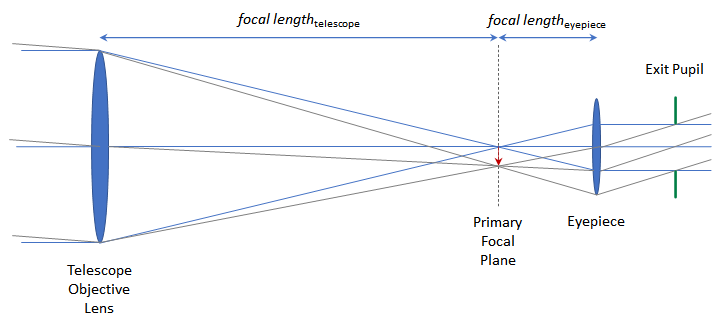When I first started taking pictures of stars with a DSLR, I wondered what magnification I was getting with my astrophotography set up. The best answer came from an article on Cloudy Nights. That article said that there really isn’t any answer to the question of magnification in photographs, but you might approximate the magnification by considering your eye as the eyepiece at the main focal plane of your telescope. The human eye has a focal length of 22 mm, so the magnification your eye would see can be calculated by dividing the focal length of the telescope in millimeters by 22 millimeters. Using that algorithm gave me about the same measurements I was getting by estimating from my pictures, so it seemed to be a reasonable and simple answer to a question that had no answer.
Recently, someone in the Syracuse Astronomical Society asked how to calculate magnification when using a camera on a telescope. Seeing the same question pop up again spurred me to ponder anew. This time around, I began asking why the article I found said that there was no real answer to the question. After thinking it over in my sleep, it occurred to me that there is a problem talking about magnification in pictures. When I take a photo of the Helix Nebula and post it to the web, one person might view the photo with their iPhone and see the Helix as being about 2 cm across. But if someone else views the same photo on their main computer screen, the Helix might be 5 cm wide. The larger screen has zoomed the magnification two-and-a-half times larger. Then another friend in the club raised a good point by noting that the camera in astrophotography is placed at the primary focal plane. What that means is that the person who wrote the Cloudy Nights article wasn’t kidding when they said there really isn’t an answer to the question of magnification using a camera as the eyepiece on a telescope. My friend further raised the point that it might take a diagram to clarify why this is true. That spurred me to make such a diagram (see below) and write this little article.

Magnification is calculated by dividing the focal length of the telescope by the focal length of the eyepiece.
focal length of the eyepiece
An eyepiece, or your eye, has a focal length, so it is possible to calculate the magnification. But if you put the sensor of your camera at the primary focal plane, there is no focal length to use as the denominator of the magnification equation. Therefore, astrophotographers report the field of view of their pictures instead of magnification. No matter how much you enlarge your photo, the field of view will remain the same. You can calculate the magnification you see when you look at photos if you measure the angle of view your eye sees when you view the picture. This equation is:
apparent angular size of the object in the sky
When viewing a picture of the Great Hercules Cluster, M13, the angular size from the photo might be 20° while M13 has an apparent angular size of 20 arcminutes. 20° is equal to 1200 arcminutes, so the magnification as viewed in the picture would be 1200’/20’ or 60 times. It’s all done with mathematics.
